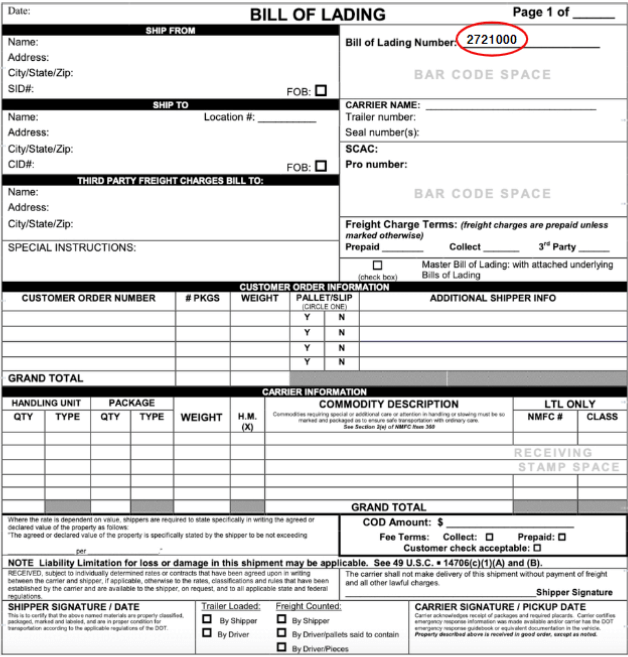Last Updated August 26, 2025
Turn your unpaid invoices into working capital for your business
In shipping and logistics, transparency and organization should always be at the forefront. And when it comes to ensuring transactions are well-organized and properly documented, applying a number to each bill of lading makes life easier for all parties involved.
Bill of lading numbers assist with shipment tracking, dispute resolution, and delivery integrity. Its role in ensuring the smooth operation of global trade can’t be understated, so let’s review bill of lading numbers to assure you that you’re applying these numbers correctly.
What Is a Bill of Lading Number?
A bill of lading number—often abbreviated as BOL number—is the unique identifier for a bill of lading document. It is issued by the carrier once a shipment is booked and used to track and manage cargo. Think of it like a fingerprint for freight. Each shipment is recognized and traced through the complex networks of global logistics.
This numeric code is the key reference point for shippers, carriers, and consignees. It’s essential for accessing detailed information about the shipment, such as its current status, historical routing, and delivery confirmation.
Why Is a Bill of Lading Number Important?
Every successful owner-operator should understand the importance of a bill of lading number since it’s so significant for tracking purposes. It allows all parties to monitor a shipment’s progress, ensuring security and accuracy by linking the cargo to its detailed documentation. This means it’s easy to resolve any potential disputes or claims between the shipping and receiving parties.
Further, the bill of lading number helps streamline customs clearance. Customs authorities use the number to verify shipments, assess duties, and ensure compliance with import and export regulations. It ensures a smooth transfer of goods from carrier to consignee and fosters more efficient operations overall.
Bill of Lading Number Formatting (with Example)
The bill of lading number format is not uniform across the board. It varies by carrier or logistics company.
While many BOL numbers are alphanumeric, which combines letters and numbers to create a unique identifier, some may only consist of numbers. The flexibility in format means each shipment can be precisely tracked and managed throughout its journey.
For example, a purely numeric number might look like “2721000.” Below, we’ve presented an example of where that number would go on the actual bill of lading.

In-Summary: What Is a Bill of Lading Number?
A bill of lading number essentially has the same purpose as an invoice number; it assists parties involved in shipping and logistics transactions with quickly identifying bills for tracking, reporting, and potential dispute purposes.
No matter your process for implementing and recording BOL numbers, consistency is key. Apply them in the same location on each document and keep a spreadsheet so you can easily find past BOLs. While this might be a small step in the grand scheme of starting and running a trucking business, it’s an ever important one.
Bill of Lading Number FAQs
What is the difference between a BOL and a PRO number?
A BOL (bill of lading) number is a unique identifier issued by the carrier that outlines the terms of shipping. It serves as a receipt and, in some cases, a document of title. A PRO number, on the other hand, is used primarily for tracking and managing freight shipments. It’s assigned by carriers to individual shipments and is crucial for tracking purposes. This allows customers to monitor their shipment’s status from pickup to delivery.
What is an SID number on a BOL?
An SID (shipment identification) number on a bill of lading is another unique identifier used to track and manage shipments. Unlike the BOL number, which covers the entire shipping document and contract, the SID number is typically used to identify specific shipments or orders within a larger consignment.
How many digits are on a BOL number?
The length of a BOL number can vary depending on the carrier or the logistics service provider. Generally, BOL numbers can range from 8 to 16 alphanumeric characters. This variability allows carriers the flexibility to create unique identifiers that fit their tracking and documentation systems.
Where does a BOL number go?
The BOL number is prominently displayed on the bill of lading document, usually at the top or in a dedicated section that’s easily visible upon first inspection. This placement ensures that the number can be quickly referenced by the carrier, shipper, and consignee throughout the shipping process, from loading to delivery.
Interested in Factoring?
Turn your unpaid invoices into working capital so you can keep growing your trucking business.
Jennifer Lockett is the Freight Factoring Operations Manager at altLINE, the factoring division of The Southern Bank Company. Jennifer joined altLINE to spearhead the launch of the company’s new freight factoring program, bringing with her eight years of experience in the factoring industry and 18 years in the general trucking industry. Her firsthand experience working closely with drivers over the years has allowed her to carefully evaluate situations from a carrier’s point of view and navigate challenges effectively.









